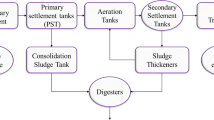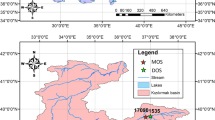Abstract
In recent years, artificial intelligence methods have proved appropriate for the treatment of environmental problems. This paper presents a novel work for the assessment and prediction of water quality in shrimp aquaculture based on environmental pattern processing. Water quality studies are based on analyzing negative concentrations of compounds in shrimp ponds that inhibit good growth and reproduction of organisms. The physical–chemical variables are classified based on the negative ecological impact using the Gamma (Γ) classifier, which calculates the frequency and deviation of the measurements from a specific level. A fuzzy inference system processes the level classifications using a reasoning process that determines when a specific concentration is good or harmful for the organism and provides a water quality index, which describes the condition of the ecosystem: excellent, good, regular, and poor. An autoregressive model (AR) predicts a section of an environmental signal using historical information, and the set of predicted variables are assessed in order to estimate future water quality conditions in the system. This methodology emerges as a suitable and alternative tool to be used in developing effective water management plans.










Similar content being viewed by others
References
Angulo CA, Angulo CU (2003) Study of the water quality and its relationship with white shrimp growing (Litopenaeus Vannamei), in the shrimp pond of Agua Verde S.A. de C.V. Rosario, Sin. M.Sc. Thesis, Universidad Autónoma de Sinaloa
Arredondo J, Ponce J (1998) Water quality in aquaculture. Ed. AGT SA
Australian Bureau of Statistics (ABS) (2003) A guide to interpreting time series—monitoring trends
Becerra M, Iano Y, Tarumoto M (2008) Evaluating some Yule-Walker Methods with the maximum-likelihood estimator for the spectral ARMA model. Tendências Matemática Aplicada Comput 9(2):175–184
Bell T (1992) Principals of shrimp culture chemotherapy. In: Proceedings of the special session on shrimp farming. World Aquaculture Society, USA, pp 227–237
Boyd C, Musing Y (1992) Shrimp pond effluents: observations of the nature of the problem on commercial farms. In: Proceedings of the special session on shrimp farming. World Aquaculture Society, USA
Brockwell P, Davis R (1996) Introduction to time series and forecasting. Springer, New York
Canadian Council of Ministers of the Environment (Canada) (CCME) (2004) An assessment of the application and testing of the water quality index of the Canadian Council of Ministers of the Environment for selected water bodies in Atlantic Canada. National indicators and reporting office. Available at: http://www.ec.gc.ca/soer-ree/N [Accessed August 2007]
Chapra S, Canale R (1999) Numerical methods for engineers. McGraw-Hill, México
Chatfield C (2004) The analysis of time series: an introduction, 6th edn. Chapman & Hall/CRC, London
Chien Y (1992) Water quality requeriments and management for marine shrimp culture. In: Proceedings of the special session on shrimp farming. World Aquaculture Society, USA, pp 144–156
Chow M (1997) Methodologies of using neural network and fuzzy logic technologies for motor incipient fault detection. World Scientific, Singapore
Cohen L (1995) Time–frequency signal analysis. Prentice Hall PTR, Englewood Cliffs
Cohen J, Samocha T, Fox J (2005) Characterization of water quality factors during intensive raceway production of juvenile Litopenaeus vannamei using limited discharge and biosecure management tools. Aquacult Eng 32 Elsevier: 425–442
De la Fuente D, García D (1998) Modelado de series temporales con métodos en bloque y recursivos. Desarrollo de estimadores y predictores adaptativos. Questiió 12:281–313
Dijkhof W, Wensik E (2000) Small sample statistics of the yule-walker method for autoregressive parameter estimation. In: Proceedings of European signal processing conference
Emmanuel C (1993) Digital signal processing: a practical approach. Addison-Wesley, Reading
Gutiérrez J (2004) Lógica difusa como herramienta para la bioindicación de la calidad del agua con macroinvertebrados acuáticos en la sabana de Bogotá–Colombia. Caldasia 26(1):161–172
Gutiérrez J, Riss W, Ospina R (2006) Bioindicación de la calidad del agua en la sabana de Bogota–Colombia, mediante la utilización de la lógica difusa neuroadaptativa como herramienta. Limnología Caldasia 28(1):45–46
Hirono Y (1992) Current practices of water quality management in shrimp farming and their limitations. In: Proceedings of the special session on shrimp farming. World Aquaculture Society, USA
Instituto Nacional de Ecología (INE) (2000) La calidad del agua en los ecosistemas costeros de México
Kenneth H (1998) Water quality prediction and probability network models. North Carolina State University, USA
Kenney J, Keeping E (1962) Mathematics of statistics, 3rd edn. Van Nostrand, Princeton
Li Y, Li J, Wang O (2006) The effects of dissolved oxygen concentration and stocking density on growth and non-specific immunity factors in chinese shrimp, Fenneropenaeus chinensis. Aquaculture 256 Elsevier:608–616
Lin JY, Cheng CT, Chau KW (2006) Using support vector machines for long-term discharge prediction. Hydrolog Sci J 51(4):599–612
Martínez L (1994) Cultivo de camarones pendidos, Principios y prácticas, Ed. AGT Editor SA
Martínez L (1998) Ecología de los sistemas acuícolas. AGT Editor, México
Muttil N, Chau KW (238) 2006. Neural network and genetic programming for modeling coastal algal blooms Int J Environ Pollution(28):3–4–223
National Sanitation Foundation International (NSF) (2005). Available at: http://www.nsf.org [Accessed August 2007]
Navarro L, Mascarenhas A, Durazo R (1992) Una nota sobre la temperatura y salinidad de la capa superior del océano en la entrada del golfo de california en agosto 1992. Ciencias Marinas 23
Ocampo W, Ferré N, Domingo J, Schuhmacher M (2006) Assessing water quality in rivers with fuzzy inference systems: a case study. Environ Int 32 Elservier:733–742
Páez OF (2001) Camaronicultura y medio ambiente. Instituto de Ciencias del mar y Limnología. UNAM, México, pp 271–298
Proakis J, Manolakis D (2007) Tratamiento digital de señales. Pearson Education, vol. 1, 4ª Ed. España
Samocha T (1992) Shrimp nursery systems and management. World Aquaculture Society, LA, pp 87–105
Secretaría de Medio Ambiente, Recursos Naturales y Pesca (SEMARNAP) (2006) NOM-001-ECOL-1996
Secretaría de Medio Ambiente y Recursos Naturales (SEMARNAT) (2005) Available at: http://www.semarnat.gob.mx. Accessed Aug 2007
Shumway R, Stoffer D (2000) Time series analysis and its applications. Springer, New York
Soler V (2007) Lógica difusa aplicada a conjuntos imbalanceados: aplicación a la detección del síndrome de down. Departament de Microelectrònica i Sistemes Electrònics, Universitat Autònoma de Barcelona, Ph.D. Thesis
Yañez C, López I, De la Luz G (2008) Analysis and prediction of air quality data with the gamma classifier. Lecture Notes in Computer Science. Springer, New York, pp 651–658
Acknowledgments
The authors of the present paper would like to thank the following institutions for their support in developing this work: National Polytechnic Institute, Mexico, Biology Research Centre of Sonora (CIB) and CONACyT.
Author information
Authors and Affiliations
Corresponding author
Appendix A
Appendix A
Canadian Council Ministers of Environment Water Quality Index
The percentage of the number of parameters whose objective limits are not met: \( F_{1} = {\frac{{{\text{Number}}\;{\text{of}}\; {\text{failed}}\;{\text{variables}}}}{{{\text{total}}\;{\text{of}}\; {\text{number }}\;{\text{of}}\; {\text{variables}}}}} \times 100 \) | The percentage of individual tests that do not meet the objectives \( F_{2} = {\frac{{{\text{Number}}\;{\text{of}}\;{\text{failed}}\;{\text{tests}}}}{{{\text{total}}\;{\text{of}}\;{\text{number}}\;{\text{of}}\;{\text{variables}}}}} \times 100 \) |
When the test value must not exceed the objective: \( {\text{excursion}}_{i} = {\frac{{{\text{objective}}_{i} }}{{{\text{Failed}}\;{\text{test}}\;{\text{value}}_{i} }}} - 1 \) | For the cases in which the test value must not fall below the objective:\( {\text{excursion}}_{i} = {\frac{{{\text{Failed}}\;{\text{test}}\;{\text{value}}}}{{{\text{objective}}_{i} }}} - 1 \) |
normalized sum of excursions (nse) is calculated as \( {\text{nse}} = {\frac{{\mathop \sum \nolimits_{i = 1}^{n} {\text{excursion}}_{i} }}{{{\text{number }}\;{\text{of}}\;{\text{test}}}}} \) | Asymptotic function that scales the normalized sum of the excursions from objectives (nse) to yield a value between 0 and 100. \( F_{3} = {\frac{\text{nse}}{{0.01{\text{nse}} + 0.01}}} \) |
The CCME is calculated as: \( {\text{CCME}} = 100 - \left( {{\frac{{\sqrt {F_{1}^{2} + F_{2}^{2} + F_{3}^{2} } }}{1.732}}} \right) \) | |
Rights and permissions
About this article
Cite this article
Hernández, J.J.C., Fernández, L.P.S. & Pogrebnyak, O. Assessment and prediction of water quality in shrimp culture using signal processing techniques. Aquacult Int 19, 1083–1104 (2011). https://doi.org/10.1007/s10499-011-9426-z
Received:
Accepted:
Published:
Issue Date:
DOI: https://doi.org/10.1007/s10499-011-9426-z




